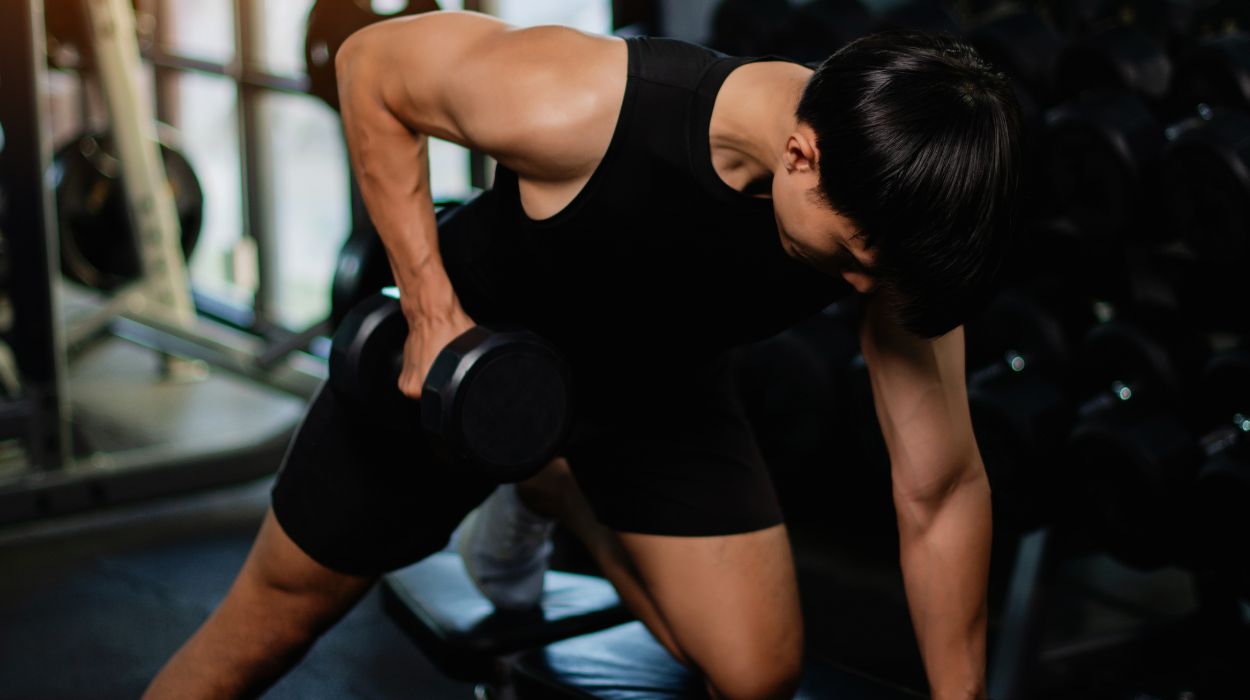
The rear deltoid, or the rear delt, is one of three components of the shoulder muscle. The anterior deltoid and medial deltoid are the other components. As the name suggests, the rear delt is on the back of your shoulder – playing a vital role in optimal movement function and posture.
Many effective rear delt dumbbell exercises are easily included in an upper body workout routine. Other simple rear delt exercises can be performed with cables, pin-loaded machines, and resistance bands. It’s important to approach this muscle with proper technique and gradually increase the weight – being aware of your breath can also help properly execute the exercises.
The shoulder joint moves through a large range of motion compared to other joints in the body. This can increase the risk of injury if certain muscles, including the deltoids, are weak or dysfunctional.
Best Rear Delt Exercises With Dumbbells
- Seated Dumbbell Rear Delt Fly: Strengthens the rear deltoids and surrounding muscles, contributing to enhanced shoulder function. Improves shoulder function.
- Chest-Supported Dumbbell Row: Isolates the upper back muscles.
- Standing Rear Delt Dumbbell Raise/Reverse Dumbbell Fly: Strengthens postural muscles.
- Standing Lateral Dumbbell Raise: Improves shoulder motor control.
- Prone Dumbbell Y Raise: Improves postural strength.
- Incline Dumbbell T Raise: Strengthens to support optimal posture.
- Single Arm Bent Over Dumbbell Raise: Targets the posterior muscles in the shoulders.
- Single Arm Bent Over Rear Delt Row: Effectively works the rear delts.
- Seated Dumbbell Arnold Press: Encapsulates the entire delt for strengthening.
Best Rear Delt Dumbbell Exercises In 2024
Strengthening your rear delts contributes to well-balanced and robust shoulders, which are crucial in injury prevention,[1] especially with throwing. Continue reading to learn key movement points and considerations for rear delt exercises with dumbbells. As well as how you can easily create a shoulder workout at home with only a pair of dumbbells.
Seated Dumbbell Rear Delt Fly
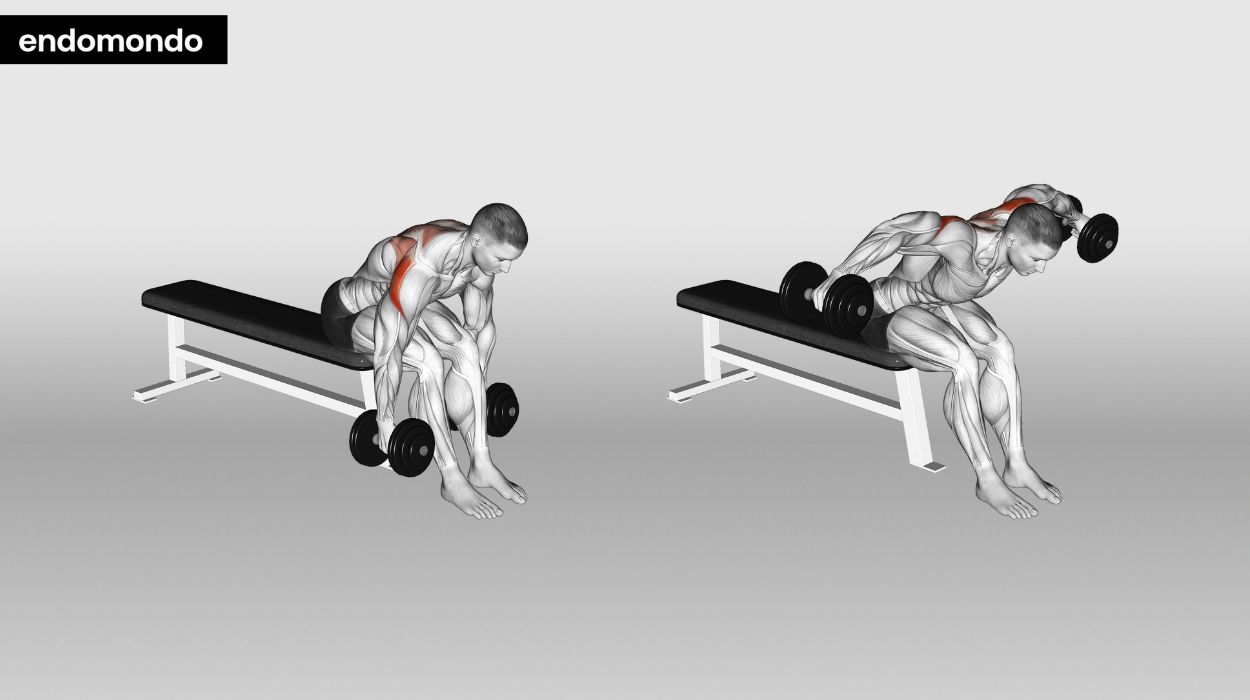
The seated dumbbell rear delt fly exercise targets the rear deltoids as well as surrounding muscles in the shoulders. This exercise develops shoulder strength and contributes to efficient movement mechanics of the shoulder blades.
How to do:
- Begin by sitting at the edge of a bench with feet hip-width apart.
- Lean forward from the hips so your chest is facing the floor in front of you.
- Pick up the dumbbells from the floor with an overhead grip, palms facing toward you.
- With your arms straight and a slight bend in the elbow, initiate the movement by raising the dumbbells out to your sides until they’re approximately shoulder height.
- Pause at the top and slowly lower the dumbbells to behind your calves.
- Repeat for the prescribed number of sets and reps.
Tips:
- Maintain your position as best as possible; if you feel you can’t complete the movement without your torso raising or relying on momentum, it’s likely the weight is too heavy.
- Choose a weight that allows you to perform each repetition to the full range of motion in a strict and controlled manner.
- Think about squeezing your shoulder blades together at the top of each rep.
- Pause for one second at the top before returning to the starting position.
- Be sure to set your shoulder blades before initiating the movement. Allowing the shoulder to raise toward the ear can cause injury.
- Take a breath in and engage your core before initiating the movement, slowly exhale as you lower the weights back down to the start position.
Optimal Sets And Reps: Two to three sets of 8-12 repetitions.
Chest-Supported Dumbbell Row
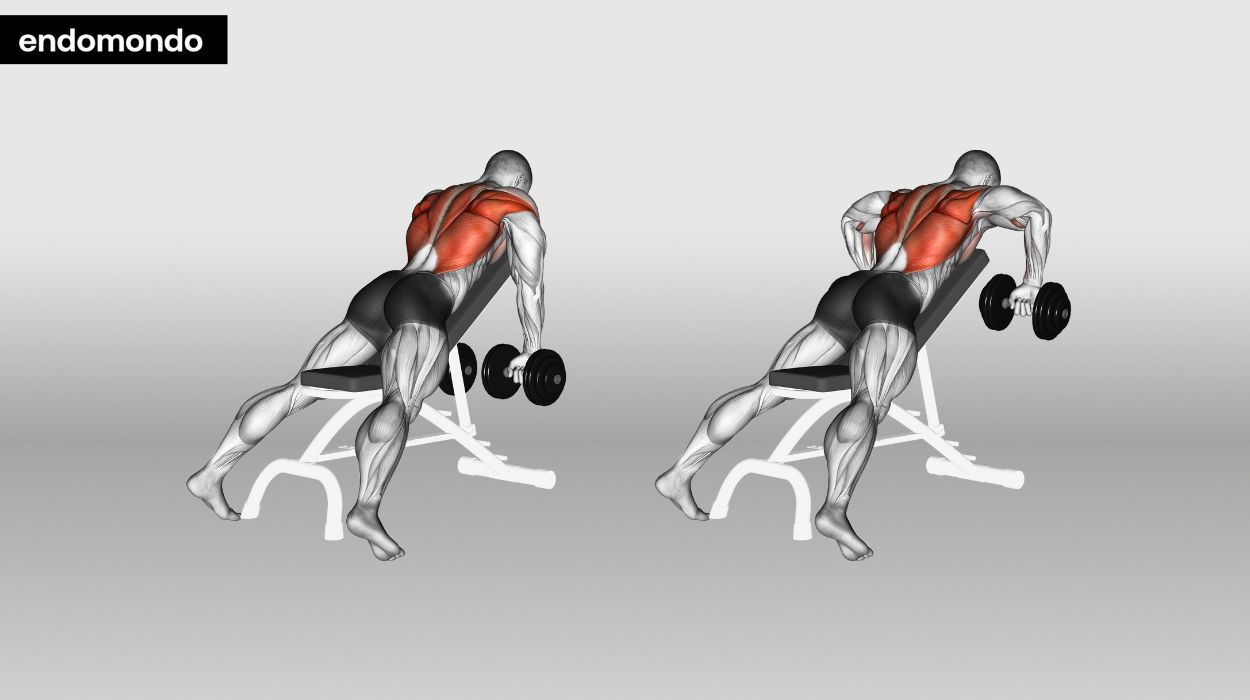
The chest-supported dumbbell row is an excellent exercise that targets the upper back and posterior shoulder muscles when performed correctly. This exercise is a great row variation for beginners or individuals who struggle to maintain correct posture during row exercises. The bench provides support, removing the requirement to maintain position throughout the movement – allowing the individual to isolate and effectively engage the intended muscles.
How to do:
- Set an adjustable bench to 45 degrees.
- Start with a pair of light dumbbells, holding them in each hand.
- Bring your feet to the end of the bench and rest the dumbbells on the top portion of it.
- Lower yourself down to sit on the bench with your chest resting on the inclined portion of the bench. Position yourself so your chin is off the bench, with your whole chest in contact with it.
- Make sure your feet are driving into the ground so you have a stable foundation.
- Extend your arms down with a neutral grip.
- To initiate the movement, pull your elbows back and down driving the dumbbells towards your hips.
- At the top, squeeze your shoulder blades together, briefly pause, and then slowly lower the dumbbells back to the start position.
Tips:
- Choose a light, comfortable weight that allows you to work through the full range of this movement with control.
- Don’t rely on momentum to lift the dumbbells; decrease the weight if you find yourself doing this.
- Squeeze your shoulder blades together at the top; imagine you have a coin between them to tap into the mind-muscle connection.
- Pull the dumbbells down to your hips, and keep your elbows close to your body.
- Be sure to keep your chest firmly in contact with the bench through the entire movement; if you find it rising the weight you have chosen may be too heavy.
Optimal Sets And Reps: Two to three sets of 10-15 reps.
Standing Rear Delt Dumbbell Raise/Reverse Dumbbell Fly
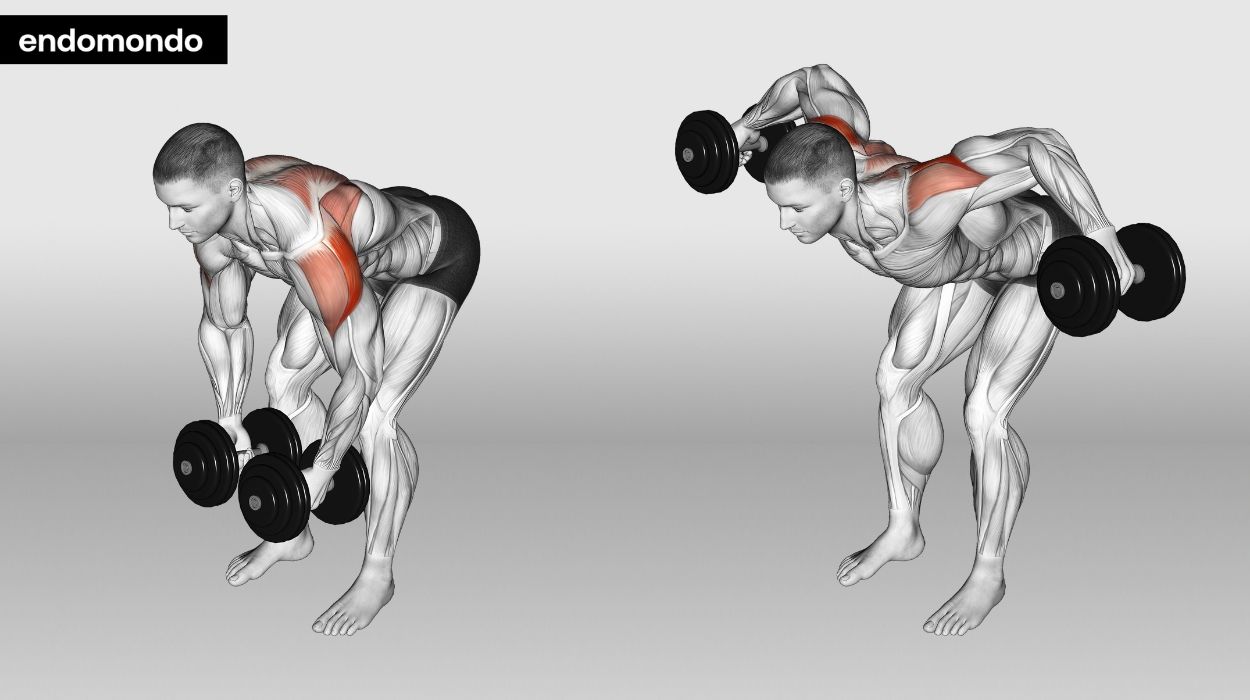
The standing rear delt dumbbell raise, or reverse dumbbell fly, increases upper body strength, particularly in the posterior shoulder muscles. Due to the postural demands required to maintain the position, this exercise may feel challenging for beginners. However, establishing and executing the correct form is paramount to engaging the intended muscles regardless of individual level.
How to do:
- Start with your feet shoulder-width apart and knees slightly bent. From here, hinge forward so your chest faces the ground.
- Maintain a neutral spine and ensure your core and back are actively engaged to support your posture.
- Holding two light dumbbells, extend your arms out in front of you while keeping a slight bend in the elbow.
- Initiate the movement by raising the dumbbells out and up, focusing on leading with your elbows.
- Control the dumbbells back to the starting position.
Tips:
- Ensure you actively maintain a strong posture throughout the work period.
- Avoid relying on momentum to raise the dumbbells. Be sure to set your shoulder blade before lifting so as not to engage the upper trapezius. If you feel your torso or chest raising when you raise the dumbbells, you’re likely compensating because the weight is too heavy.
- Start with a lightweight that allows you to complete all reps of each set with sound technique.
Optimal Sets And Reps: Two to three sets of 10-15 reps.
Standing Lateral Dumbbell Raise
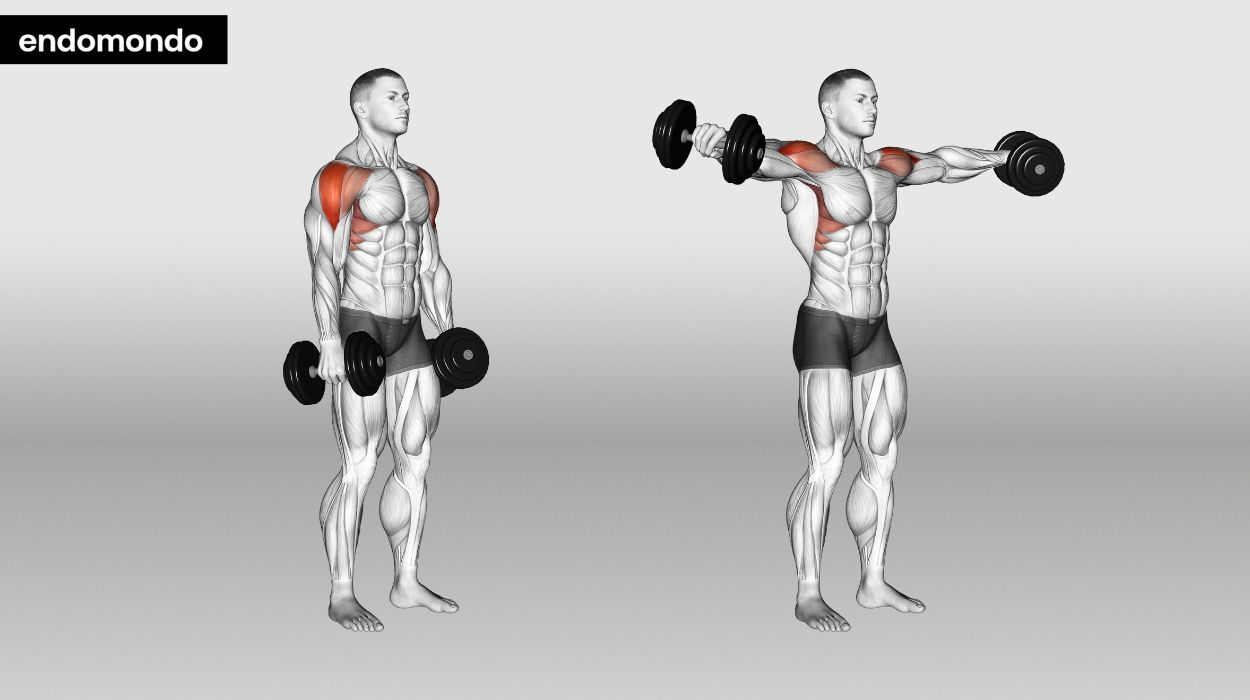
The standing lateral dumbbell raise engages all three components of the deltoid, helping improve muscular control. While it is typically used to strengthen the lateral deltoid,[2] it also effectively works the anterior and rear deltoid muscles. This exercise is an excellent addition to a shoulder and bicep workout routine for a well-rounded upper-body session.
How to do:
- Holding two light dumbbells by your sides and palms facing inward, stand up straight with your feet shoulder-width apart.
- With a slight bend in your elbow and arms extended, initiate the movement by raising the dumbbells to shoulder height.
- Slowly lower the dumbbells back down to your sides.
- Pause for a second and repeat for the prescribed number of repetitions.
Tips:
- Be sure to maintain your posture, engage your core throughout the movement, and avoid arching through your back.
- Start with a very lightweight to perform this movement properly.
- Focus on maintaining a slow and controlled tempo throughout the whole phase of this exercise.
Optimal Sets And Reps: Two to three sets of 10-15 reps.
Prone Dumbbell Y Raises
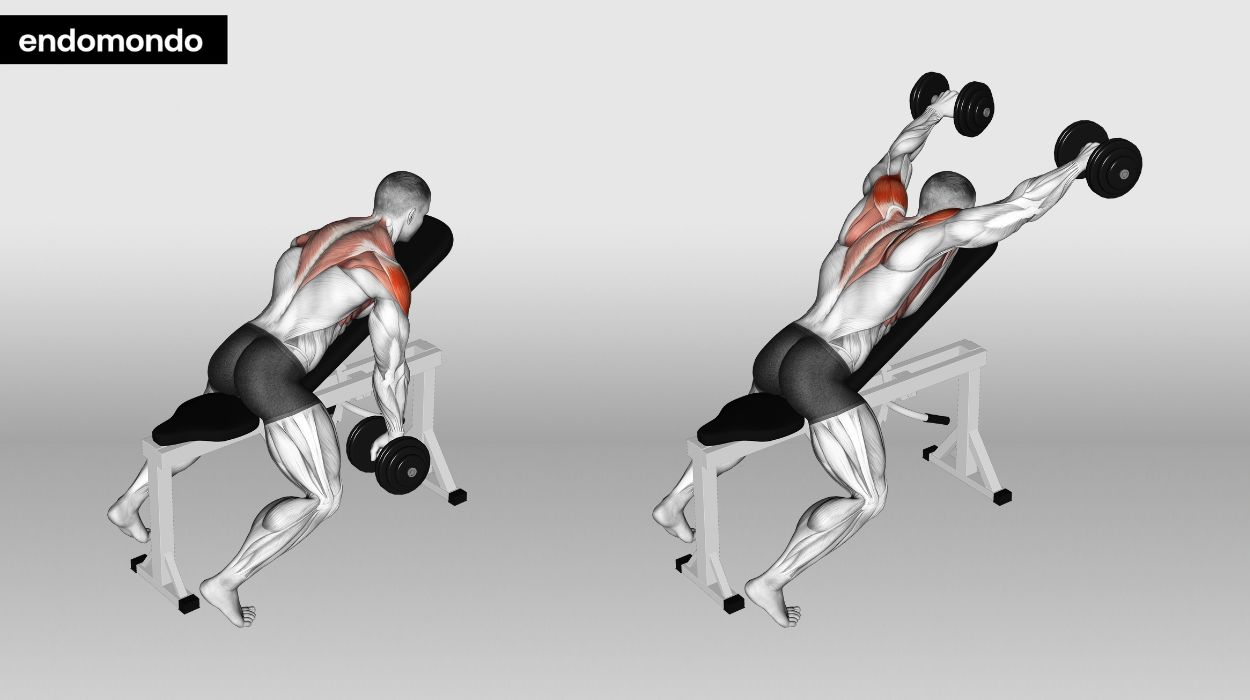
Prone dumbbell Y raises are an excellent option for targeting the deltoid muscles and surrounding posterior muscles of the upper back. This exercise helps strengthen the lower trapezius muscles while developing and enhancing shoulder joint control. Moreover, performing this movement will help increase strength and joint stability, a vital component anyone can benefit from.
How to do:
- Set an adjustable bench to 60 degrees or use an incline bench.
- Position yourself on the bench with your chest and torso maintaining contact.
- Holding two light dumbbells with an overhand grip, extend your arms fully and set your shoulder blades back and down.
- Initiate the movement by raising the dumbbells out to approximately a 45-degree angle in front of you, as if you’re making a Y shape.
- Slowly lower the dumbbells back to the starting position with control.
- Repeat the steps for the prescribed number of repetitions.
Tips:
- This exercise will require a very lightweight to perform correctly.
- Focus on the position of your shoulder blades throughout the movement.
- Make sure your shoulders don’t shrug up as you raise the dumbbells.
Optimal Sets And Reps: Two to three sets of 10-15 reps.
Incline Dumbbell T Raise
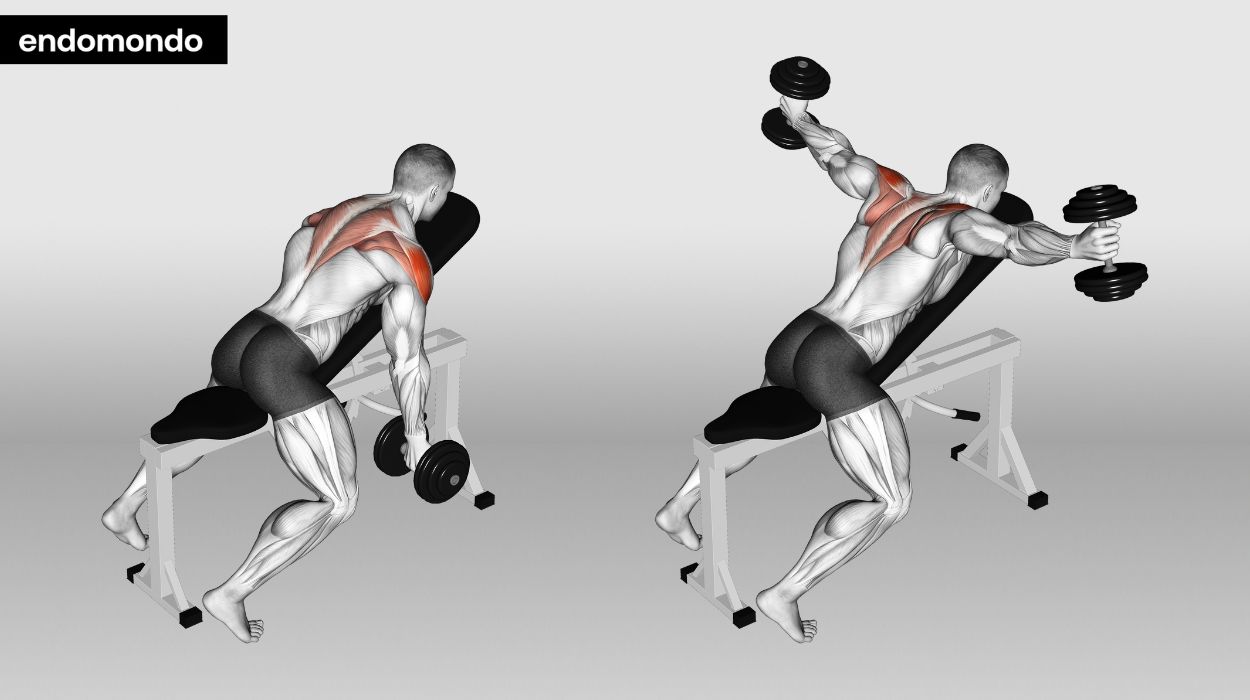
The incline dumbbell T raise is similar to the Y raise in position and set-up; however, you will bring your arms directly out to your sides for this movement. This exercise predominantly targets the deltoids, including rear delts, while engaging the mid back. It’s important to start light and gradually increase the weight once ample strength is developed in this movement.
Even if you mainly use machine exercises, this could be included as a warm-up. If you don’t have access to a bench, this could be completed lying down on an exercise mat. Lastly, this exercise could be particularly beneficial for individuals who spend a lot of time in front of a computer – helping mitigate potential postural issues.
How to do:
- Position yourself on an incline bench with your feet firmly driving into the ground.
- Holding two light dumbbells with your palms facing inward, relax, and extend your arms.
- Initiate the movement by raising the dumbbells directly to your sides until they align with your shoulders.
- Pause briefly at the top of the movement, then slowly lower the weights and back down.
- Repeat for the desired number of sets and reps.
Tips:
- Focus on maintaining a slow and controlled pace through the entire movement.
- Don’t rely on momentum to raise the dumbbells; instead, choose a weight you can lift with proper form.
- Focus on lowering the weight back down with control.
Optimal Sets And Reps: Two to three sets of 10-15 reps.
Single Arm Bent Over Dumbbell Row
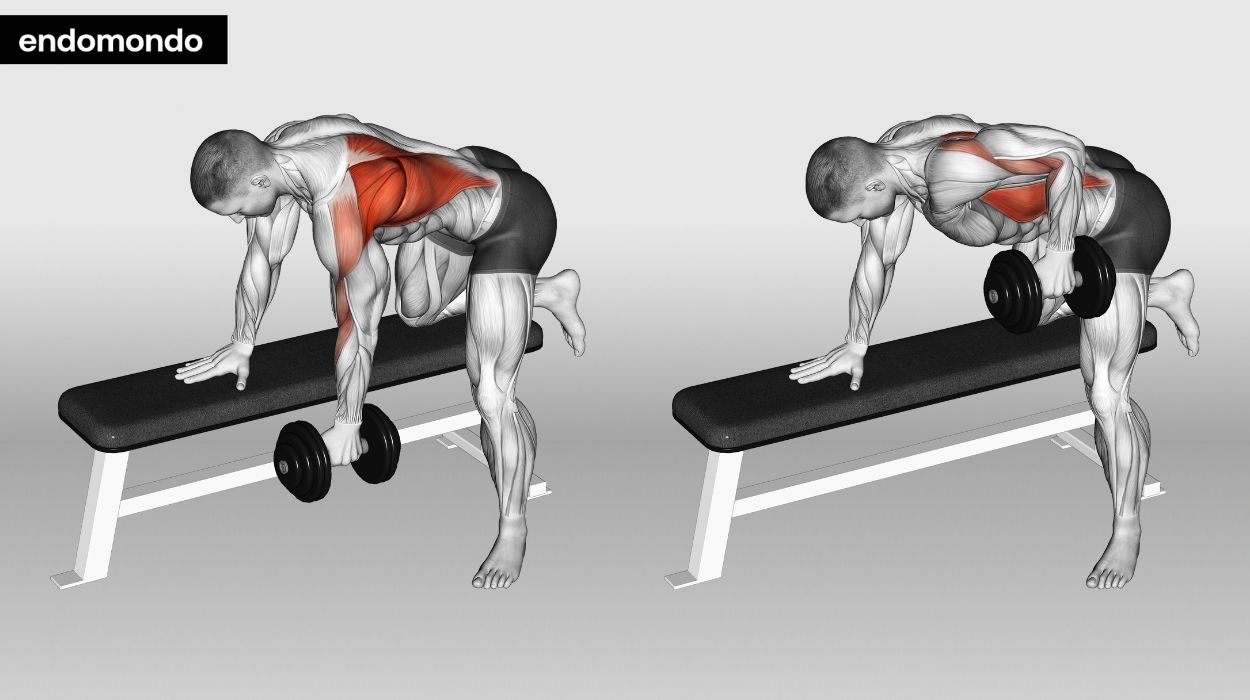
The dumbbell single-arm bent-over row is an excellent unilateral exercise that engages the entire posterior portion of the back. In particular, this exercise engages the lats, rear delts, and back stabilizing muscles.[3] Although this is a popular exercise in many workout programs, some common faults can compromise its effectiveness.
Keep reading to learn how to execute this movement for optimal results and key tips to be mindful of. To perform this movement, you’ll need a bench and one dumbbell.
How to do:
- Place your right knee on the bench and firmly plant your right palm on it. With a slight bend in your knee, place your left leg one to two steps out to the side while keeping your hips square. Keep your back in a neutral position.
- With a neutral wrist and arm fully extended, hold one dumbbell in your left hand. Initiate the movement by pulling the dumbbell up and slightly back until your elbow just passes your torso. Think about driving the dumbbell towards your hip bone rather than directly up to your chest.
- Squeeze your shoulder blade at the top of the movement and control the weight back down.
- You can extend your arm further down to get a stretch through your shoulder.
- Once all reps are completed on the left side, use the same steps to set up and complete the reps on the right.
- Repeat the steps for the prescribed number of sets and reps.
- Complete equal amounts on both sides using the same weight.
Tips:
- Don’t force the dumbbell up with momentum or by raising your torso.
- Keep your elbow tucked close to your body.
- Don’t flare your elbow out too wide to the side or too high.
- Don’t arch or slouch through your back; remain engaged throughout the movement using your breath to appropriately engage your core.
Optimal Sets And Reps: Two to three sets of 10-15 reps on each side.
Single Arm Bent Over Rear Delt Dumbbell Row
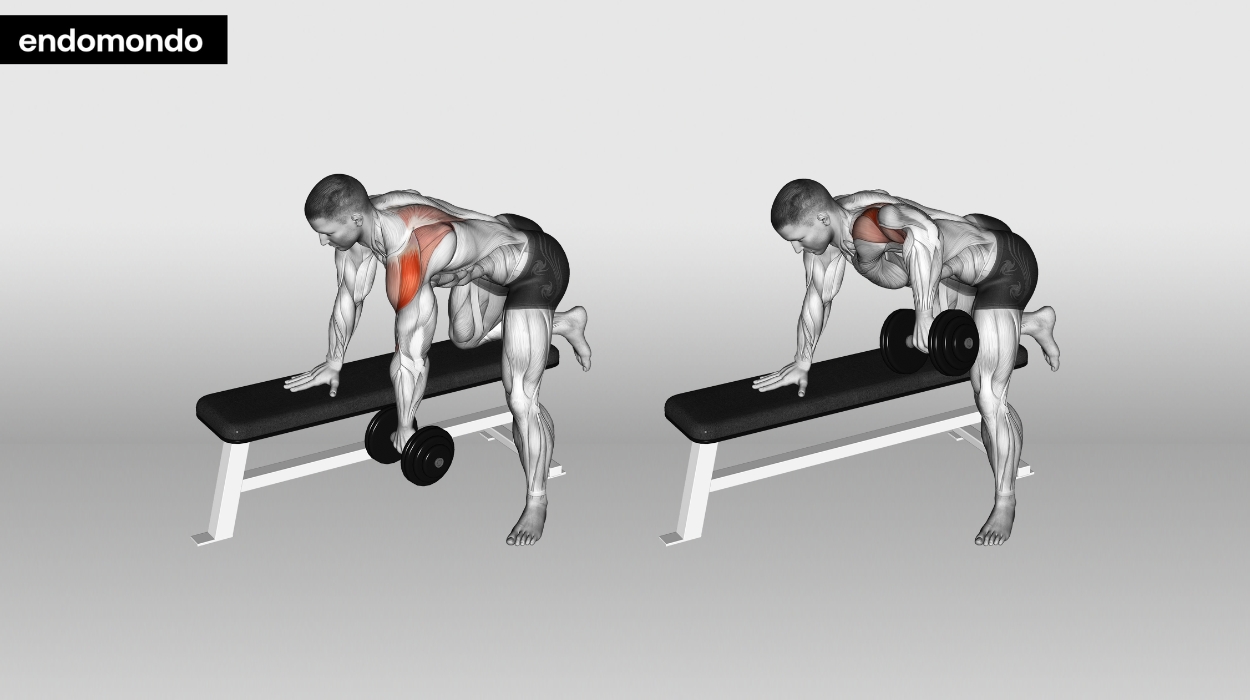
Similar to the bent-over dumbbell row, the rear delt row applies the same set-up and positions with a slight variation to the movement path. This bent-over row variation emphasizes the rear delts rather than the lats. Start with a comfortable weight and progressively increase over time.
How to do:
- Place your right knee on the bench and firmly plant your right palm on it. With a slight bend in your knee, step your left leg out slightly wider while keeping your hips square. Keep your back in a neutral position.
- With a neutral wrist and left arm fully extended, hold one dumbbell in your left hand. Initiate the movement by pulling the dumbbell up and out to the side of your body. Your elbow should be pointing up to the sky at the top of the movement.
- Lower the weight back down to the start position and repeat until you have completed all reps.
- Complete the same amount of repetitions on the right side.
Tips:
- Don’t force the dumbbell up with momentum or by raising your torso.
- Choose an appropriate weight to perform all sets and reps without compromising your technique.
- Keep a neutral back through the entire movement and use your breath to engage your core. Make sure to exhale on the lift.
Optimal Sets And Reps: Two to three sets of 10-15 reps on each side.
Seated Dumbbell Arnold Press
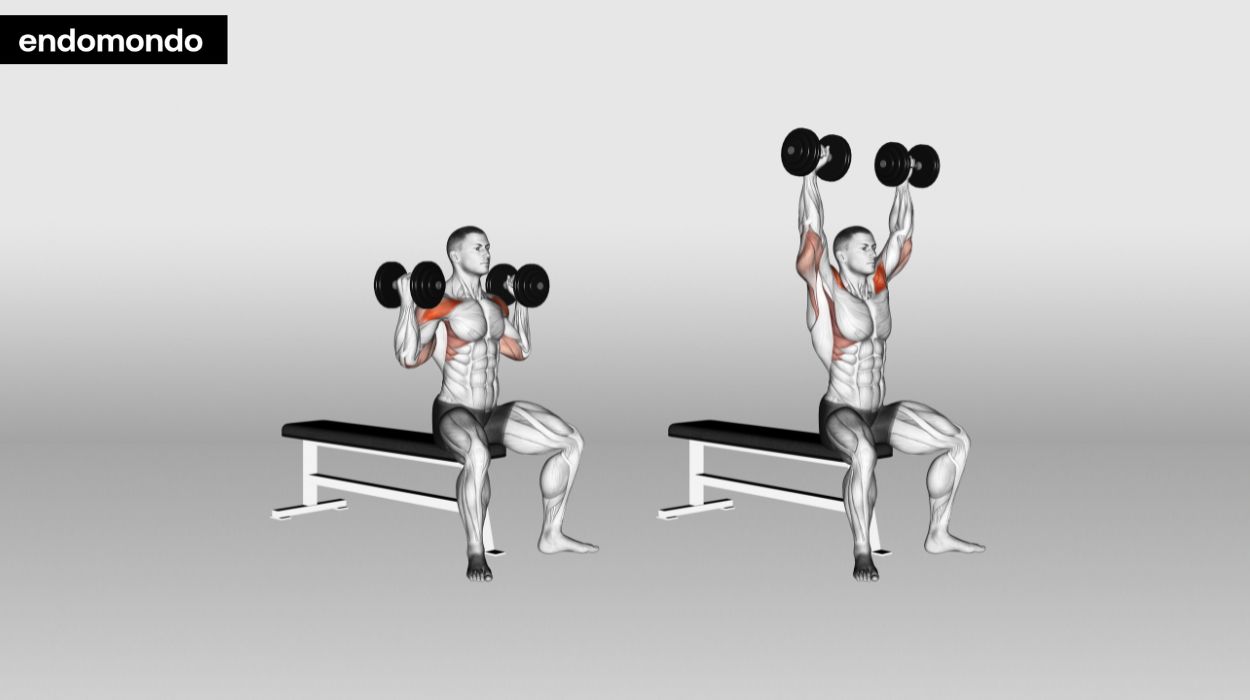
The dumbbell Arnold press is a variation of the generic dumbbell shoulder press which adds rotation to the movement. The rotational aspect of this exercise engages all three deltoid components- the anterior, rear delt, and lateral deltoids. This makes it one of the most effective and time-efficient shoulder exercises.
The Arnold press can promote shoulder function, enhance the overhead range of motion, and improve shoulder stability.
How to do:
- Sit on the edge of a bench and assume an upright posture with your feet hip-width apart and directly under your knees.
- Bring the dumbbells to your collarbones, with your palms facing towards you; this is the start position.
- Initiate the movement by rotating your palms outwards while pressing the dumbbells overhead until your arms are fully extended and your palms face away from you.
- Lower the dumbbells by performing the movement in reverse, rotating your palms back to face you as you bring the dumbbells back to the starting position just above your collarbones.
- Maintain an upright posture through the entire movement with your core engaged.
- Repeat for the desired number of reps.
Tips:
- Choose a moderate weight that enables you to complete all sets and reps without compromising your form.
- Avoid overarching through your back at the top of the movement. If you cannot maintain your posture, consider choosing lighter weights for the next set.
- Don’t flare your elbows out too wide; maintain a relatively vertical movement path from your shoulders overhead.
Optimal Sets And Reps: Two to three sets of 10-15 reps.
Rear Delt Anatomy And Function
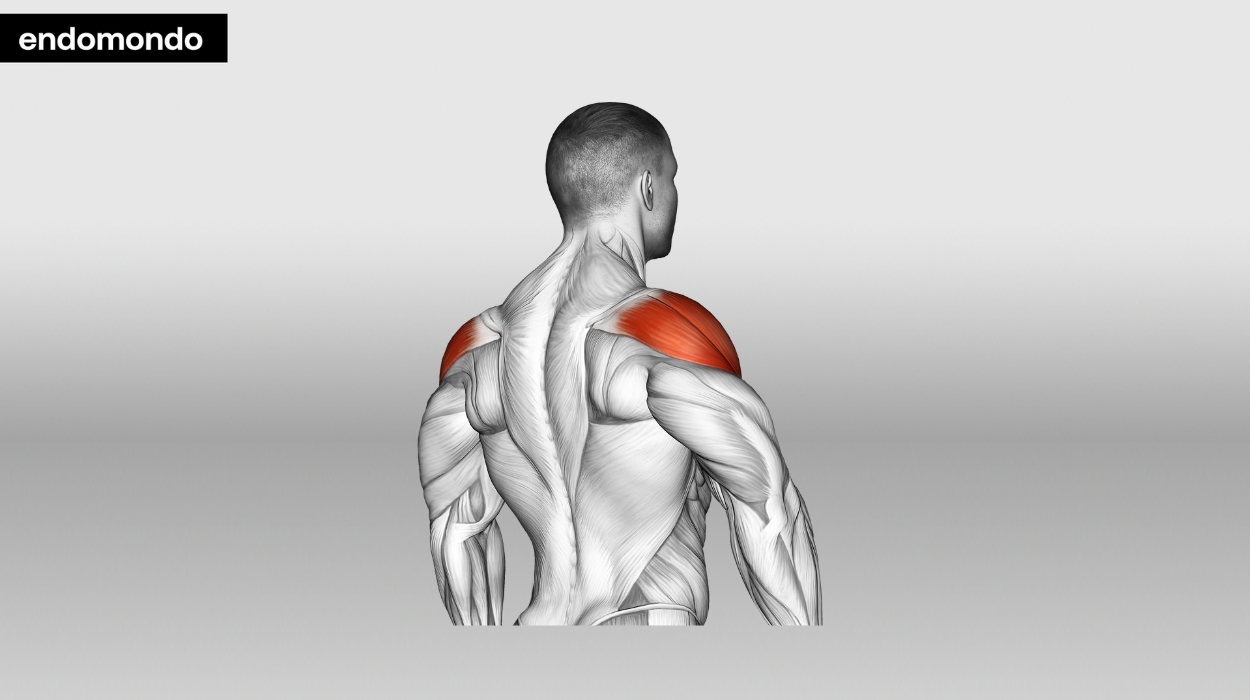
The rear delt muscle is also commonly known as the posterior deltoid, signifying its location on the body. The desire to get bigger shoulders has a strong appeal for many individuals. So understanding the anatomy can help them train and grow effectively.
The deltoid muscle[4] spans from the scapula (shoulder blade) and extends to the humerus, the bone of the upper arm. Additionally, the deltoid has three points of origin.[5] These are the spine of the scapula, the clavicle (collarbone), and the acromion (the part of the shoulder blade that meets the collarbone).
The deltoid muscle supports the shoulder through flexion, extension, and abduction movements. The posterior deltoid,[5] in particular, is responsible for extension, external rotation, and horizontal abduction[6] – an example of this is extending your arms in front of you and moving them out to your sides. The rear delts also play an important role in shoulder stabilization, especially during abduction movements.
Why Should You Train Your Rear Delt Muscles?
Training your rear deltoids is crucial for building robust and well-balanced shoulder muscles. From an aesthetic standpoint, training the rear deltoids contributes to overall body composition and appearance. Some gym-goers get caught up in focusing only on front deltoid exercises often neglecting the other components of this muscle; leading to muscle imbalances as well as an increased risk of injury over time.
Therefore, to avoid possible injuries that could result in taking a break from working out altogether; it is essential to target all components of the deltoid.
Moreover, training your rear deltoid properly can also support the following:
- Overall muscle balance of the shoulder and upper body.
- Optimal shoulder function.
- Optimal posture and movement mechanics.
- Improved functional strength.
- Ability to execute daily tasks[7] well, including reaching, extending, carrying, and lifting objects.
- Enhanced physical performance in physical activity and athletic endeavors.
Injury Prevention Tips
Injuries are, unfortunately, always a possibility. However, the good news is that many employing certain strategies can help reduce and limit the likelihood of injuries. To reduce your risk of injury in the gym or at home with dumbbells, follow these essential tips below:
Always Perform A Proper Warm-Up
Performing an adequate warm-up before starting your actual working sets is paramount for reducing your risk of injury. An ample warm-up should first include a general warm-up to elevate the body’s temperature and heart rate. It should be followed by a specific warm-up targeting the muscles you will be working.
Including lighter sets is also essential rather than going straight to a moderate-heavy load. Lastly, an effective warm-up can benefit you by improving mobility, warming up the joints, and supporting enhanced physical performance.
Maintain Proper Technique
Proper technique is essential not only to maximize the outcome of the exercise but also to prevent injuries from occurring. Poor technique can lead to other muscles or joints overcompensating, leading to imbalances or heightened injury risk.
Follow A Well-Balanced Program
Common injuries can arise from methods that can be easily avoided, such as overuse. While volume is essential for muscle and strength development to a certain point – performing excessive volume or overtraining a specific muscle or muscle group can lead to muscle strain.
Allow For Adequate Rest And Recovery
You must factor in appropriate rest and recovery to support progress and avoid injury. Pushing yourself too hard or training excessively so you cannot recover properly increases the risk of injuries and can slow results. Follow a well-structured training program, ensure enough sleep each night, and maintain a nutrient-dense diet to support your goals.
Conclusion
Strong rear delts are as important as any other muscle in the body. Overlooking this critical component can lead to muscle weakness, imbalances, and reduced function, which may cause compensation elsewhere. An effective shoulder workout should include a balance of exercises that adequately target the different muscles of the upper body.
Including exercises that target the rear delts specifically in your upper body training program will help develop robust, versatile shoulders. Remember that it’s still important to do so in a balanced manner; you follow a well-structured program that accounts for all muscle groups rather than hyper-focusing on certain ones. To accelerate results, include an adequate warm-up before each session and maintain proper technique.
If you want to mix up your dumbbell workout after a while, you could also incorporate some barbell shoulder workouts. As always, if you’re unsure of a particular movement, it’s best to seek proper guidance before attempting it yourself.
Frequently Asked Questions
Lateral raises have been shown to have the highest rear delt activation.[6] It’s worth noting that performing any exercise incorrectly or with poor technique will not improve strength and hypertrophy.
Performing two sets of a rear delt exercise might be a suitable starting point, especially for beginners. A general range is two to three sets of 8-12 repetitions at a weight that can be controlled throughout the entire movement.
You can target your rear delts with cables with exercises like standing cable rear delt flys, face pulls, cable wide grip rows, cable upright rows, and single arm bent-over cable flys.
While pull-ups predominantly work the lats, they also work the rear delts. The overhand grip used when performing a pull-up will influence which upper back muscles are engaged.
Yes, dumbbell rows target and engage the rear deltoids in conjunction with the lats. When performing dumbbell rows, it’s important to work through the entire movement with as much control as possible.
It’s not recommended to do rear delt workouts every day. Adequate rest is vital for the muscle to recover, adapt, and grow stronger.
The rear delts can seem challenging to grow compared to other muscles, as individuals may find it difficult to engage the muscles effectively. It could also be attributed to improper form and not performing enough volume.
You could develop muscle imbalances in your shoulders and upper body. This can increase the risk of injury even in basic daily actions, for example, reaching to grab something off a shelf.
Resources
- Rosso, C., Mueller, A.M., McKenzie, B., Vahid Entezari, Cereatti, A., Ugo Della Croce, Ramappa, A.J. and DeAngelis, J.P. (2014). Bulk effect of the deltoid muscle on the glenohumeral joint. Journal of Experimental Orthopaedics, [online] 1(1). doi:https://doi.org/10.1186/s40634-014-0014-9.
- Coratella, G., Tornatore, G., Longo, S., Esposito, F. and Emiliano Cè (2020). An Electromyographic Analysis of Lateral Raise Variations and Frontal Raise in Competitive Bodybuilders. International Journal of Environmental Research and Public Health, [online] 17(17), pp.6015–6015. doi:https://doi.org/10.3390/ijerph17176015.
- A. Saeterbakken, Andersen, V., A. Brudeseth, Lund, H. and Fimland, M.S. (2015). The Effect of Performing Bi- and Unilateral Row Exercises on Core Muscle Activation. International Journal of Sports Medicine, [online] 36(11), pp.900–905. doi:https://doi.org/10.1055/s-0034-1398646.
- Ahmet Kurtoglu (2023). Investigation of Deltoid Muscle Activation From Different Angles in Body Building Athletes. Şişli Etfal Hastanesi tıp bülteni, [online] pp.410–415. doi:https://doi.org/10.14744/semb.2023.09522.
- McCausland, C., Sawyer, E., Eovaldi, B.J. and Varacallo, M. (2023). Anatomy, Shoulder and Upper Limb, Shoulder Muscles. [online] Nih.gov. Available at: https://www.ncbi.nlm.nih.gov/books/NBK534836/#article-28998.s2.
- Yuri, Vianna, J.M., Guimarães, M.P., Jorge, Hernández-Mosqueira, C., Silva and Marchetti, P.H. (2020). Different Shoulder Exercises Affect the Activation of Deltoid Portions in Resistance-Trained Individuals. Journal of Human Kinetics, [online] 75(1), pp.5–14. doi:https://doi.org/10.2478/hukin-2020-0033.
- José Inácio Salles, Velasques, B., Cossich, V., Nicoliche, E., Ribeiro, P., Marcus Vinicius Amaral and Motta, G. (2015). Strength Training and Shoulder Proprioception. Journal of Athletic Training, [online] 50(3), pp.277–280. doi:https://doi.org/10.4085/1062-6050-49.3.84.




